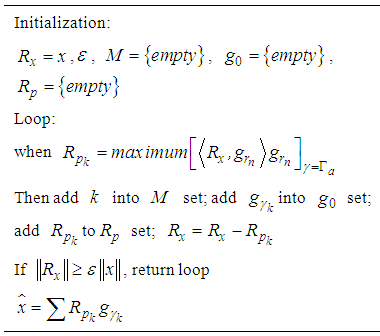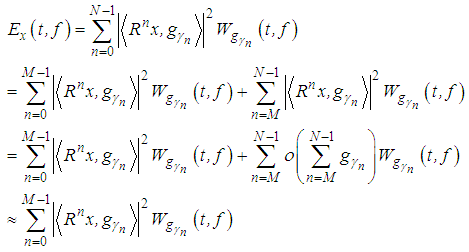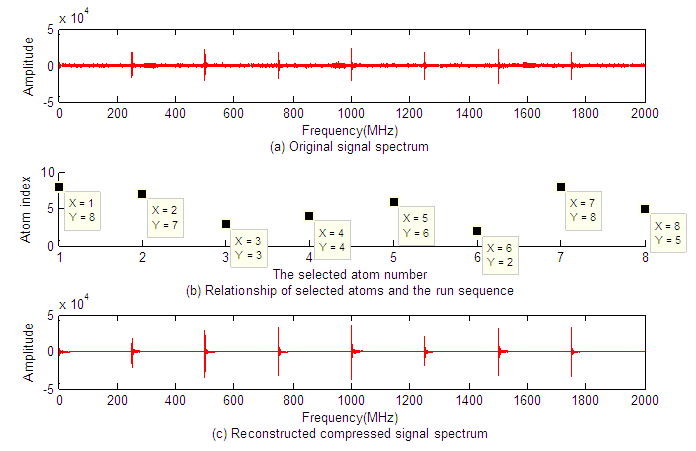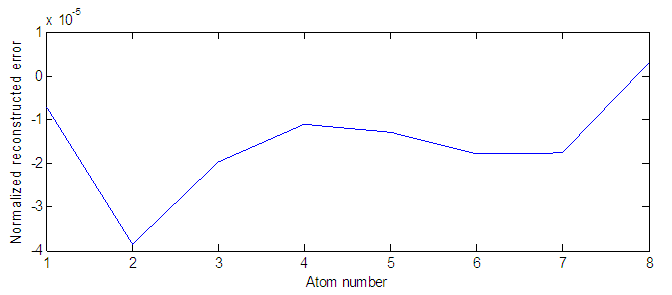-
Paper Information
- Previous Paper
- Paper Submission
-
Journal Information
- About This Journal
- Editorial Board
- Current Issue
- Archive
- Author Guidelines
- Contact Us
Computer Science and Engineering
p-ISSN: 2163-1484 e-ISSN: 2163-1492
2015; 5(1A): 15-22
doi:10.5923/s.computer.201501.03
A Wideband Spectrum Sensing Method Based on Compressed Sensing by Using Matching Pursuits
1College of Electrical and Automation Engineering, Hefei University of Technology, Hefei, China
2College of Physics and Information Science, Hunan Normal University, Changsha, China
3Department of Electrical and Computer Engineering, Texas A&M University, College Station, TX, USA
Correspondence to: Lifen Yuan , College of Electrical and Automation Engineering, Hefei University of Technology, Hefei, China.
| Email: |  |
Copyright © 2015 Scientific & Academic Publishing. All Rights Reserved.
Secondary users are considered for using the licensed spectrum without causing harmful interference to the primary users in cognitive radios, which results in a challenge for spectrum sensing. Spectrum sensing is an ability of secondary users to independently detect spectral opportunities without any assistance from primary users. The methods based on standard analog-to-digital converters could lead to unaffordable high sampling rate or implementations for wideband spectrum sensing. Based on the compressed sensing theory, a wideband spectrum sensing method is presented. Gabor functions are selected to build the atom dictionary for exploring the sparse representation of the wideband signal. Matching pursuit algorithm is introduced to select the optimal atoms that can result in the most sparsity of representation. Finally, Wigner-distribution is used to reconstruct the spectrum of the wideband spectrum on the sparse representation. Simulation results show that this method can greatly decrease the sampling rate of the wideband signal and sense the primary user’s existence successfully.
Keywords: Wideband spectrum sensing, Matching pursuits, Gabor atoms
Cite this paper: Lifen Yuan , Mi Lu , A Wideband Spectrum Sensing Method Based on Compressed Sensing by Using Matching Pursuits, Computer Science and Engineering, Vol. 5 No. 1A, 2015, pp. 15-22. doi: 10.5923/s.computer.201501.03.
Article Outline
1. Introduction
- Since cognitive radios(CR) are considered secondary users for using the licensed spectrum, a crucial requirement of cognitive radio network is that they must efficiently exploit underutilized spectrum without causing harmful interference to the Pus (primary users). Furthermore, PUs have no obligation to share and change their operating parameter for sharing spectrum with cognitive radio networks. Hence, cognitive radios should be able to independently detect spectral opportunities without any assistance form PUs. CR has emerged as one of the most promising candidate solutions to improve spectrum utilization in next generation cellular networks [1]. Spectrum sensing encompasses a collection of procedures intending to determine the occupancy state of a particular frequency band which is of great importance for CR. From the bandwidth of the spectrum of interesting, sensing techniques can be classified into two categories: narrowband and wideband. Usually, there are three popular sensing techniques: energy detection [2, 3], cyclostationary feature detection [4, 5], and compressed sensing [6, 7]. Energy or cyclostationary detection is based on a set of observations sampled by ADC (analog-to-digital converter) at Nyquist rate in the band of interest. Different from narrowband spectrum sensing, wideband spectrum sensing aims to find more spectral opportunities over a wide frequency range and achieve higher opportunistic aggregate throughput in cognitive radio networks. However, conventional wideband spectrum sensing techniques based on standard analog-to digital converters(ADCs) could lead to unaffordably high sampling rate or implementation complexity, thus revolutionary wideband spectrum sensing techniques become increasingly important. Due to hardware limitations on the sampling speed, these sensing techniques are primarily used to sense one band at a time. To sense multiple frequency bands, CR users may need to scan the spectrum or use multiple RF frontends for sensing multiple bands. However, using these approaches for wideband sensing either causes long sensing delay or incurs higher computational complexity and hardware cost. Compressed sensing (CS) is a new type of sampling theory, which predicts that sparse signals can be reconstructed from what is previously believed to be incomplete information. Report says that localized temporal and geographic spectrum utilization is extremely low [8], which means CS is a promising candidate to realize wideband spectrum sensing. Recent studies on compressed sensing have led to a significant amount of work on wideband spectrum sensing based on sub-Nyquist sampling [9-14]. These work focus on exactly reconstructing the primary signal. However, the assumptions in most of the work need to be relaxed for building a practical sensing algorithm. According to the sparseness of the wideband spectrum, sub-Nyquist sampling can be introduced to extend these methods. What’s more, CS is a transformation which mapping the signal from one space to another space, and the basis functions for transformation are critical for finding all the PUs’ spectrum while putting these methods into practice.Against this background, the novel contribution of this paper is that a CS sensing algorithm is presented to sense wideband spectrum. Considering the translation invariance requirement for sensing spectrum, Gabor wavelet is introduced to construct the atoms dictionary which is the basis for signal transformation, and matching pursuit theory is used to exploiting the optimal atoms for signal representation.The rest of the paper is organized as follows. Section 2 introduces the system model. Section 3 proposes a wideband spectrum sensing algorithm based on matching pursuit theory. Simulation results are presented in Section 4, and conclusions are given in Section 5.
2. System Model
- Suppose that CRs aim to exploit spectral holes within frequency band
 . The received signal at the CRs is first down-converted to baseband before further signal processing and decision making. Without loss of generality, we consider only the equivalent baseband received signals
. The received signal at the CRs is first down-converted to baseband before further signal processing and decision making. Without loss of generality, we consider only the equivalent baseband received signals  throughout the paper. The process of cooperative sensing starts with spectrum sensing performed individually at each CR user called local sensing. Typically, local sensing for primary signal detection can be formulated as a binary hypothesis problem as follows [15]:
throughout the paper. The process of cooperative sensing starts with spectrum sensing performed individually at each CR user called local sensing. Typically, local sensing for primary signal detection can be formulated as a binary hypothesis problem as follows [15]: | (1) |
 is the equivalent baseband signal received by secondary user during the sensing period,
is the equivalent baseband signal received by secondary user during the sensing period,  is the signal from the primary user,
is the signal from the primary user,  is stochastic noise, and
is stochastic noise, and  is the temporary amplitude gain of the channel.
is the temporary amplitude gain of the channel.  and
and  denote as the hypotheses of the absence and the presence of the primary user. By using sampling rate
denote as the hypotheses of the absence and the presence of the primary user. By using sampling rate  over the observation time τ, we could obtain a discrete time sequence
over the observation time τ, we could obtain a discrete time sequence  , in a vector form
, in a vector form . Here,
. Here,  is chosen to be a natural number.Document [8] reports that localized temporal and geographic spectrum utilization are extremely low. What’s more, compressive theory indicates that, if a signal is sparse in some basis, it can be reconstructed by using signal sampled with a sub-Nyquist sampling rate. Mathematically, by using sub-Nyquist sampling rate
is chosen to be a natural number.Document [8] reports that localized temporal and geographic spectrum utilization are extremely low. What’s more, compressive theory indicates that, if a signal is sparse in some basis, it can be reconstructed by using signal sampled with a sub-Nyquist sampling rate. Mathematically, by using sub-Nyquist sampling rate , the compressed samples
, the compressed samples  can be written as
can be written as | (2) |
 denotes an
denotes an  measurement matrix. For spectrum sensing system, the goal is to reconstruct
measurement matrix. For spectrum sensing system, the goal is to reconstruct  or its discrete Fourier transform (DFT) spectrum
or its discrete Fourier transform (DFT) spectrum  denotes a DFT matrix ) from
denotes a DFT matrix ) from  [16].
[16].3. Wideband Spectrum Sensing Algorithm Based on Matching Pursuit
3.1. Compressed Sampling
- Let
 be a Hilbert space, we define a dictionary as a family
be a Hilbert space, we define a dictionary as a family  of vectors in
of vectors in  , such that
, such that  ,
,  are called time-frequency atoms. Depending upon the choice of time-frequency atoms, the decomposition might have very different properties. Let
are called time-frequency atoms. Depending upon the choice of time-frequency atoms, the decomposition might have very different properties. Let  be the closed linear span of the dictionary vectors. Finite linear expansions of vectors in
be the closed linear span of the dictionary vectors. Finite linear expansions of vectors in  are dense in the space
are dense in the space  . We say that the dictionary is complete if and only if
. We say that the dictionary is complete if and only if  . When the signal space
. When the signal space  has a finite dimension
has a finite dimension  , the dictionary
, the dictionary  may have an infinite number of elements and it is supposed to be complete. Document [17] gives an efficient implementation of matching pursuit algorithm and prove that the norm of residues decays exponentially, which is very important for sparse representation.Suppose
may have an infinite number of elements and it is supposed to be complete. Document [17] gives an efficient implementation of matching pursuit algorithm and prove that the norm of residues decays exponentially, which is very important for sparse representation.Suppose  is a finite index set included in
is a finite index set included in  such that for any
such that for any 
 | (3) |
 and the dictionary redundancy, set
and the dictionary redundancy, set  can be much smaller than
can be much smaller than  . The matching pursuit is initialized by computing the inner products
. The matching pursuit is initialized by computing the inner products  . Let
. Let  be the residual vector after approximating
be the residual vector after approximating  in the direction of
in the direction of  , the vector
, the vector  can be decomposed into
can be decomposed into | (4) |
 , such
, such  is chosen that
is chosen that  is maximum
is maximum | (5) |
 , and the
, and the  th order residue
th order residue  is sub decomposed into
is sub decomposed into  | (6) |
 , which closely matches the residue
, which closely matches the residue  . After
. After  iteration, the original signal can be represented as
iteration, the original signal can be represented as | (7) |
 is selected, we compute the inner product of the new residue
is selected, we compute the inner product of the new residue  with any
with any  , and an updating formula can be derived
, and an updating formula can be derived | (8) |
 . The number of iterations is the minimum
. The number of iterations is the minimum  such that
such that | (9) |
 | (10) |
 depends upon the decay rate of
depends upon the decay rate of  , and it is much smaller that N in most applications. There exists
, and it is much smaller that N in most applications. There exists and
and  can be represented as
can be represented as | (11) |
 can be written as
can be written as | (12) |
 is an observing matrix, and
is an observing matrix, and  is a matrix constructed by
is a matrix constructed by  optimal atoms. Assume
optimal atoms. Assume  and
and  corresponding to the atoms and the indices that maximum
corresponding to the atoms and the indices that maximum  , respectively,
, respectively,  and
and  corresponding to the residual and the projection of the signal.
corresponding to the residual and the projection of the signal.  is the kth
is the kth  ,
,  is the desired precision, and
is the desired precision, and  is the approximation of
is the approximation of  . The main steps of compressed sampling algorithm are summarized below.
. The main steps of compressed sampling algorithm are summarized below.
3.2. Wideband Spectrum Reconstruction
- The next step is to reconstruct wideband spectrum. First, the Wigner distribution of signal
 is introduced, which is defined as
is introduced, which is defined as | (13) |
 , defined over
, defined over  , the integral is replaced by a discrete sum
, the integral is replaced by a discrete sum | (14) |
 | (15) |
 | (16) |
3.3. Construction of Atom Dictionary
- Now the key issue is how to select atoms and how to construct dictionaries with these atoms adapted to signal properties. To analyze signal structures of different sizes, it is necessary to use time-frequency atoms with different time supports. A time-frequency atom dictionary is complete, and a general family of time-frequency atoms can be generated by scaling. Wavelet is a good choice for time-frequency atoms because it can reveal many signal properties and it can lead to a fast computational algorithm. A wavelet is a function
 with a zero average
with a zero average | (17) |
 and centered in the neighborhood of
and centered in the neighborhood of  . A dictionary of time-frequency atoms is obtained by scaling
. A dictionary of time-frequency atoms is obtained by scaling  by
by  and translating it by
and translating it by 
 | (18) |
 .Wideband spectrums are signals that have properties that rapidly change in time and frequency. The properties of a wideband spectrum are revealed by transforms that decompose signals over elementary wavelet atoms. Representing a wideband spectrum with its independent factors is a form of translation invariance that is important for spectrum sensing. Decomposition in orthonormal bases lack this translation invariance. Matching pursuits are translation invariance if calculated in translation-invariant dictionaries. An atoms dictionary
.Wideband spectrums are signals that have properties that rapidly change in time and frequency. The properties of a wideband spectrum are revealed by transforms that decompose signals over elementary wavelet atoms. Representing a wideband spectrum with its independent factors is a form of translation invariance that is important for spectrum sensing. Decomposition in orthonormal bases lack this translation invariance. Matching pursuits are translation invariance if calculated in translation-invariant dictionaries. An atoms dictionary  is translation invariant if for any
is translation invariant if for any  for
for  . From the formula (7), it can be concluded that the matching pursuit of
. From the formula (7), it can be concluded that the matching pursuit of  selects a translation by
selects a translation by  of the same vectors
of the same vectors  with the same decomposition coefficients:
with the same decomposition coefficients: | (19) |
 , a discrete Gaussian window is defined by
, a discrete Gaussian window is defined by | (20) |
 is adjusted so that
is adjusted so that  . A Gabor time-frequency frame is derived with time intervals
. A Gabor time-frequency frame is derived with time intervals  and frequency intervals
and frequency intervals  :
: | (21) |
 vectors. Theorem 5.19 in [24] proves that a necessary condition to obtain a frame is that
vectors. Theorem 5.19 in [24] proves that a necessary condition to obtain a frame is that  , and thus
, and thus  . Table 5.3 in [24] shows that for
. Table 5.3 in [24] shows that for  , the Gabor dictionary is nearly a tight frame.A multiscale Gabor dictionary is a union of such tight frames
, the Gabor dictionary is nearly a tight frame.A multiscale Gabor dictionary is a union of such tight frames | (22) |
 typically to avoid having too-small or too-large windows. Its size is thus
typically to avoid having too-small or too-large windows. Its size is thus  , and for
, and for  , it is nearly a tight frame with frame bounds
, it is nearly a tight frame with frame bounds  . A translation-invariant dictionary is a much larger dictionary obtained by setting
. A translation-invariant dictionary is a much larger dictionary obtained by setting  and
and  in (21), and it thus includes
in (21), and it thus includes  vectors. A smaller size dictionary
vectors. A smaller size dictionary  with
with  for
for  is selected in this paper. The position and frequency of this atom are refined with formula (5). It finds a close time-frequency atom
is selected in this paper. The position and frequency of this atom are refined with formula (5). It finds a close time-frequency atom  in the larger translation-invariant dictionary, which has a better correlation with
in the larger translation-invariant dictionary, which has a better correlation with  .
. 4. Simulation Results
- In simulation, we consider the wideband signals are subject to additive white Gaussian noise(AWGN) across channels, which is motivated in communication scenarios for several reasons [25]: First, widespread is approximately Gaussian distributed since they are generated as linear combinations of many independent (or nearly independent) subcarriers. Second, the Gaussian distribution is the distribution that achieves the capacity of an additive white Gaussian noise channel. Third, it is a working assumption very common in signal processing and statistics since it leads to tractable models and since many methods designed for Gaussian distributions also work even when there exist considerable departure from Gaussianity. The wideband signal used in this paper has the same style as the signal in [16]
 where
where  ,
,  is a random time offset,
is a random time offset,  is AWGN with zero mean and unit variance,
is AWGN with zero mean and unit variance,  is the receive power at CR. The overall bandwidth
is the receive power at CR. The overall bandwidth  . The signal-to-noise ratios (SNRs) are natural numbers between 7dB and 27 dB. The integer undersampling scheme in [26] is used to sample the entire bandwidth all at once, in which the sampling rate is an integer fraction of the wideband Nyquist rate. And the relationship between the frequency samples
. The signal-to-noise ratios (SNRs) are natural numbers between 7dB and 27 dB. The integer undersampling scheme in [26] is used to sample the entire bandwidth all at once, in which the sampling rate is an integer fraction of the wideband Nyquist rate. And the relationship between the frequency samples  for integer undersampling and the frequency samples
for integer undersampling and the frequency samples  for wideband Nyquist sampling is [26]
for wideband Nyquist sampling is [26] where
where  is the sub-sampling factor, which is defined as the ratio of the Nyquist rate to the actual sampling rate,
is the sub-sampling factor, which is defined as the ratio of the Nyquist rate to the actual sampling rate,  is the number of narrow-band frequency channels. Each channel has equal bandwidth
is the number of narrow-band frequency channels. Each channel has equal bandwidth  and the entire wideband width is
and the entire wideband width is  .
.  is the number of wideband Nyquist samples per channel in a sensing window. Thus the entire sensing window duration for wideband Nyquist sampling is
is the number of wideband Nyquist samples per channel in a sensing window. Thus the entire sensing window duration for wideband Nyquist sampling is  samples.
samples.  is the central frequency of the jth PU signal,
is the central frequency of the jth PU signal,  . The spectrum sensing length is
. The spectrum sensing length is  . Rather than using the Nyquist sampling rate 4GHz,
. Rather than using the Nyquist sampling rate 4GHz,  is adopted. The total samples are 20000. According to the construction of the Gabor atoms in formula (21), the parameters of the Gabor atom are set as:
is adopted. The total samples are 20000. According to the construction of the Gabor atoms in formula (21), the parameters of the Gabor atom are set as:  ,
,  ,
,  ,
,  According to the analysis in Section 3, the atoms number in a dictionary is
According to the analysis in Section 3, the atoms number in a dictionary is  for
for  , here N is the dimension of the vectors. In this simulation, the maximum atom number is set to 8. The simulation results in Fig.1 show the PU’s reconstruction when 8 times are run to select the optimal atoms. Fig.1(a) is the original signal of wideband and Fig.1(c) is the reconstructed signal using Gabor atoms based on compressive sensing, which shows that the PU’s spectrum can be reconstructed correctly. Fig.1(b) is the relationship between selected atom index and the run sequence. Fig.2 illustrates the coefficients of the selected atoms and the atom index, which shows that most of the coefficients are zero. Thus, the coefficients vector is sparse, and we should only save those nonzero coefficients and their indexes, which can decrease the memory cost greatly. Fig.3 shows the relationship between the normalized reconstructed error and the number of selected atoms, which illustrated that normalized reconstructed error is fluctuant and the local minimum error can be obtained when 2 atoms are selected.
, here N is the dimension of the vectors. In this simulation, the maximum atom number is set to 8. The simulation results in Fig.1 show the PU’s reconstruction when 8 times are run to select the optimal atoms. Fig.1(a) is the original signal of wideband and Fig.1(c) is the reconstructed signal using Gabor atoms based on compressive sensing, which shows that the PU’s spectrum can be reconstructed correctly. Fig.1(b) is the relationship between selected atom index and the run sequence. Fig.2 illustrates the coefficients of the selected atoms and the atom index, which shows that most of the coefficients are zero. Thus, the coefficients vector is sparse, and we should only save those nonzero coefficients and their indexes, which can decrease the memory cost greatly. Fig.3 shows the relationship between the normalized reconstructed error and the number of selected atoms, which illustrated that normalized reconstructed error is fluctuant and the local minimum error can be obtained when 2 atoms are selected. | Figure 1. Simulation Results of Wideband Spectrum Sensing Algorithm |
 | Figure 2. Coefficients of the selected atoms |
 | Figure 3. Reconstruction error with the number of atoms |
5. Conclusions
- The challenges in the spectrum sensing for wideband are presented. Then based on the fact that wideband spectrum sensing is critical for reliably finding spectral opportunities and achieving opportunistic spectrum access for next generation networks, a compressed sensing method is presented to solve the unaffordable sampling rate for wideband spectrum sensing. Finally, a computer simulation is done to verify the feasibility of the wideband spectrum sensing method, which shows that the method presented can greatly decrease the dimension of the signal under sub-Nyquist sampling theory.
ACKNOWLEDGEMENTS
- The work is partially supported by the National Natural Science Foundation of China (No.61102035 and No. 61201108), the Fundamental Research Funds for the Central Universities, China Postdoctoral Science Foundation (2014M551798), Chunhua Foundation of Hefei University of Technology (2014HGCH0012), Excellent Talents in Hunan Normal University (2012).
 Abstract
Abstract Reference
Reference Full-Text PDF
Full-Text PDF Full-text HTML
Full-text HTML